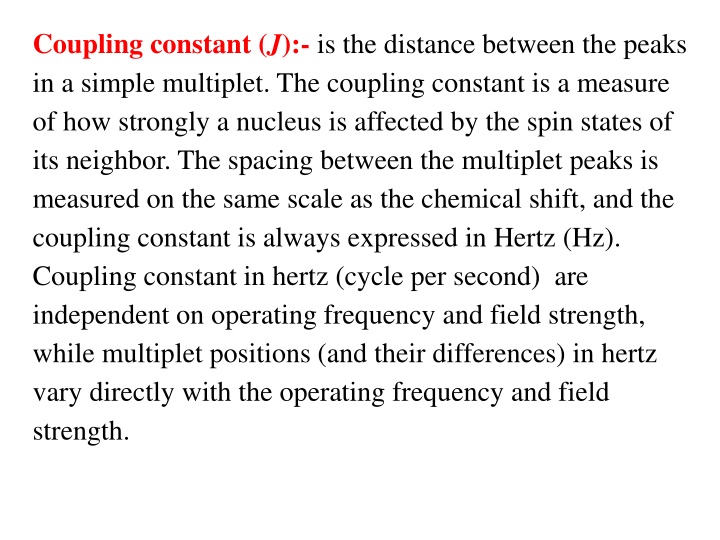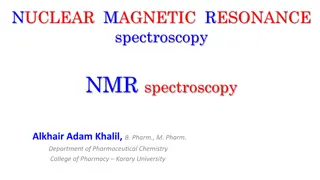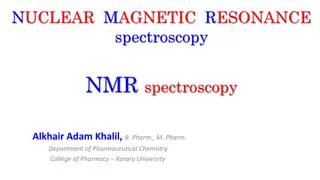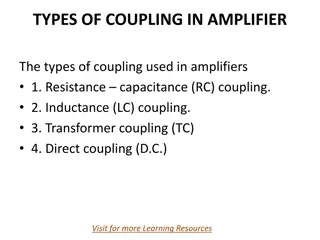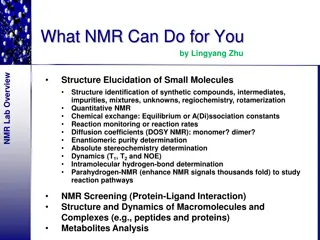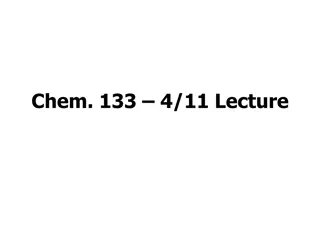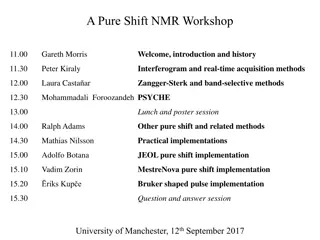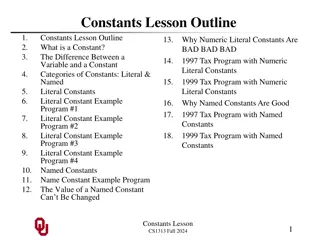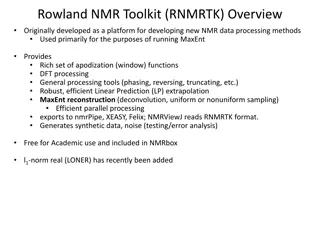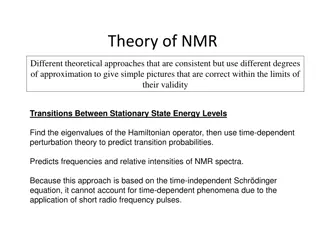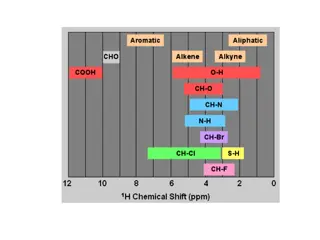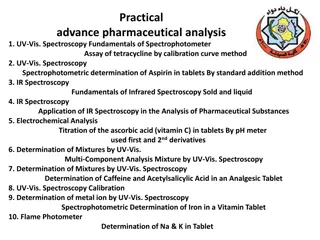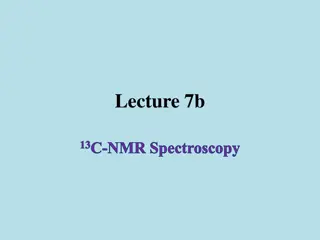Coupling Constants in NMR Spectroscopy
Coupling constants play a vital role in NMR spectroscopy by indicating the distance between peaks in a multiplet, reflecting how neighboring nuclei affect each other's spin states. They are expressed in Hertz and remain constant regardless of the operating frequency. This leads to the observation of multiplets such as doublets, triplets, and quartets, each with specific characteristics in terms of spacing, intensity ratios, and chemical shifts.
Download Presentation

Please find below an Image/Link to download the presentation.
The content on the website is provided AS IS for your information and personal use only. It may not be sold, licensed, or shared on other websites without obtaining consent from the author.If you encounter any issues during the download, it is possible that the publisher has removed the file from their server.
You are allowed to download the files provided on this website for personal or commercial use, subject to the condition that they are used lawfully. All files are the property of their respective owners.
The content on the website is provided AS IS for your information and personal use only. It may not be sold, licensed, or shared on other websites without obtaining consent from the author.
E N D
Presentation Transcript
Coupling constant (J):- is the distance between the peaks in a simple multiplet.The coupling constant is a measure of how strongly a nucleus is affected by the spin states of its neighbor. The spacing between the multiplet peaks is measured on the same scale as the chemical shift, and the coupling constant is always expressed in Hertz (Hz). Coupling constant in hertz (cycle per second) are independent on operating frequency and field strength, while multiplet positions (and their differences) in hertz vary directly with the operating frequency and field strength.
Example:-Suppose that two vicinal proton are in very different chemical environments from one another. Each proton will give rise to an absorption, and the absorption will be quite widely separated, but the spin of each proton is effected slightly by the two orientations of the other proton through the intervening electrons, so that absorption appears as a doublet.
A comparison of the two spectra indicates that the 100-MHz spectrum is greatly expanded over the 60-MHz spectrum. The chemical shift in Hertz for the CH3and CH2protons is much larger in the 100-MHz spectrum, although the chemical shifts in units (ppm) for these protons remain identical to those in the 60-MHz spectrum. The coupling constant between the CH3and CH2protons is 7.5 Hz in both spectra. The spacings of the lines of the triplet and the lines of the quartet do not expand when the spectrum of ethyl iodide is determined at 100 MHz. The extent of coupling between these two sets of protons remains constant irrespective of the spectrometer frequency at which the spectrum was determined.
There are two signals, a three line pattern (triplet)centered at 1.21, corresponding to the methyl hydrogen and a four line (quartet)pattern centered at 3.48 corresponding to the methylene hydrogen, the ratio of total areas of these two multiplets is 6:4. The multiplicity of a signal is the number of lines in the signal, so a triplet has multiplicity 3. The three lines that constitute the triplet have an intensity ratio of 1:2:1, and the spacing between neighboring lines are equal, the magnitude of these spacing s (both 7.12 Hz). The chemical shift of a multiplet is measured at its center, which in the case of a triplet corresponds to the middle line. The four- line pattern for the methylen hydrogen is a quartet and has a multiplicity 4. Its chemical shift is midway between the second and third lines the three spacing s between neighboring lines are all equal to the spacings in the triplet (7.12Hz). However, in a quartet the relative intensity of the lines is 1:3:3:1. These intensity ratios, and the fact that the spacing s in both multiplets are equal, are no accident.
J must > 1 Hz for the individual lines within a multiplet to be resolved. Value of J < 1 Hz normally render the signal a somewhat broadened singlet. Example:-what is the separation in hertz between the triplet and quartet in the spectrum of diethyl ether (250 MHz)? (b) What would be the separation if the spectrum were run at 400 MHz?
the separation expressed in (ppm) would be unchanged, 2.27 ppm.
There are two types of coupling 1. Homonuclear coupling: - Coupling between two nuclei of the same type, such as coupling between 1H and 1H. 2. Heteronuclear coupling:- Coupling between two different types of nuclei, such as the couplings between 13C and attached hydrogens are one-bond heteronuclear couplings. The magnitude of the coupling constant depends to a large extent on the number of bonds intervening between the two atoms or groups of atoms that interact. In general, one-bond couplings larger than two-bond couplings, which in turn are larger than three-bond couplings, and so forth. Consequently, the symbols used to represent coupling are often extended to include additional information about the type of atoms involved and the number of bonds through which the coupling constant operates.
We frequently add a superscript to the symbol J to indicate the number of bonds through which the interaction occurs. Thus, the symbol 1J indicates a one-bond coupling between a carbon-13 atom and a hydrogen atom (C- H) with a value of 156 Hz. The symbol 3J indicates a three-bond coupling between two hydrogen atoms, as in H-C-C-H
Homonuclear coupling :- Various types of coupling may be noted: Geminal "coupling. In the case of geminal protons (protons attached on the same carbon having different chemical environment) of a saturated compound, the value of J depends upon the bond angle The amount of geminal coupling depends on the H-C- H angle . The following Figure shows this dependencek. In general, 2Jgeminal coupling constants increase as the angle decrease.
Following are some systems that show geminal coupling, along with their approximate HCH bond angles. Notice that the coupling constants become smaller, as predicted, when the HCH angle becomes larger.
Three-Bond Couplings (3J) In a typical hydrocarbon, the spin of a hydrogen nucleus in one C-H bond is coupled to the spins of those hydrogens in adjacent C-H bonds. These H-C-C-H couplings are usually called vicinal couplings because the hydrogens are on neighboring carbon atoms (Latin vicinus = neighbor ). Vicinal couplings are three-bond couplings and have a coupling constant designated as 3J.
The magnitude of the splitting between HA and HBis greatest when = 0 or 180 and is smallest when = 90 .
Martin Karplus was the first to study the variation of the coupling constant 3JHH with the dihedral angle and developed following equation that gave a good fit to the experimental data shown in the following graph.
Quiz: - The following compound, with the formula C4H8O2, is an ester. Give its structure and assign the chemical shift values.
